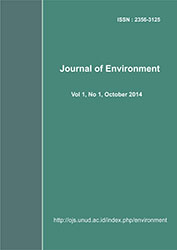Monitoring of Merapi Volcano Deformation Using Interferometry Synthetic Aperture Radar (InSAR) Technique
Abstract
The Merapi volcano is the most active volcano in Indonesia until now, because of eruption occur every two or five years. To minimize the impact of volcanic eruptions need to monitor the volcanic activity, one effort in monitoring is to monitor the surface changes (deformation) around the volcano. These surface changes can be monitored with InSAR technique. In this study monitoring by analyzing the Digital Elevation Model (DEM) and displacement map from result processing using InSAR technique. The accuracy of DEM compare with Shuttle Radar Topography Mission (SRTM) DEM. These results showed that after the eruption in 2006 led to the deflation that occurred in 2007. In 2010 after the eruption led to deflation in some areas of Merapi volcano. Whereas in 2008 due to the absence of volcanic activity that occurred then the deformation is not so large changing. Test on the DEM from the process of InSAR compare with SRTM DEM produced an accuracy of 96%.Downloads
Download data is not yet available.
Published
2014-10-03
How to Cite
PAMUNGKAS, Ayu Margaworo; OSAWA, Takahiro; ADNYANA, I Wayan Sandi.
Monitoring of Merapi Volcano Deformation Using Interferometry Synthetic Aperture Radar (InSAR) Technique.
Journal of Environment, [S.l.], v. 1, n. 1, oct. 2014.
ISSN 2356-3125.
Available at: <https://ojs.unud.ac.id/index.php/environment/article/view/11067>. Date accessed: 11 dec. 2025.
Issue
Section
Articles
Keywords
deformation; InSAR; DEM
Authors who publish with this journal agree to the following terms:
- All articles published by Journal of Environment and Graduate Study of Environmental Sciences, Udayana University are made available under an open access license worldwide immediately. This means everyone has free and unlimited access to the full-text of all articles published in Journal of Environment, and everyone is free to re-use the published material given proper accreditation/citation of the original publication. Open access publication is supported by authors' institutes or research funding agency by payment of a comparatively article processing charge for accepted articles (See Author Fees). Journal of Environment and Graduate Study of Environmental Sciences, Udayana University publish articles under the Creative Commons Attribution License.
- Authors are able to enter into separate, additional contractual arrangements for the non-exclusive distribution of the journal's published version of the work (e.g., post it to an institutional repository or publish it in a book), with an acknowledgement of its initial publication in this journal.
- Authors are permitted and encouraged to post their work online (e.g., in institutional repositories or on their website) prior to and during the submission process, as it can lead to productive exchanges, as well as earlier and greater citation of published work (See The Effect of Open Access).


